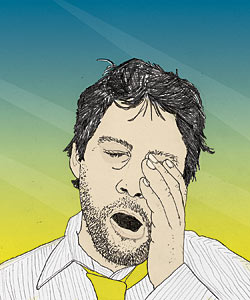
In 1953, Eugene Aserinsky, a graduate student at the University of Chicago, and his teacher, Nathaniel Kleitman, a physiology professor, discovered and documented rapid eye movement (REM) sleep—evidence of brain activity during slumber. “It stimulated the study of sleep all over the world,” says Allan Rechtschaffen, a sleep expert who worked at the U. of C. from 1958 to 1999. “Chicago was where the spark for modern sleep research was ignited.”
There was much to be learned about the subject. “A third of our life was devoted to something we knew so little about,” says James Wyatt, director of the Sleep Disorders Service and Research Center at Rush University Medical Center. Since the fifties, researchers have learned that sleep rejuvenates the brain, restores tissues and organs, assists the immune system, consolidates memory, and helps people learn and practice new motor skills. Today, the Sleep Disorders Center at the U. of C.—site of the world’s first sleep lab, established in the 1920s—helps patients of all ages manage apnea, restless legs syndrome, and other disruptive sleep behaviors.
Related:
Meanwhile, Wyatt and a colleague at Duke University have significantly changed our understanding of insomnia. Based on their research, the new Diagnostic and Statistical Manual of Mental Disorders, due out in 2013, will acknowledge that insomnia rarely occurs without a reason; it often coexists with other medical or mental disorders or with substance-abuse problems.
Unfortunately, over the past half century, as all that research was going on, the length of time a typical U.S. adult or adolescent spent sleeping decreased by one and a half to two hours a night, and 30 percent of Americans from ages 30 to 64 report spending less than six hours per night at rest. (On average, children need about nine and a quarter hours of sleep, and adults need about eight and a half.)
This lack of rest puts everyone at risk. “You’re basically operating in an impaired state,” says Eve Van Cauter, director of the U. of C.’s sleep research program. A tragic case in point: In 1998, Eugene Aserinsky, then 77, died when his car crashed into a tree after he fell asleep while driving.
* * *
It comes back to problems with circadian rhythm, the body’s roughly 24-hour cycle that is tied to lightness and darkness. When people stay up late, their body clocks get pushed back and they feel almost jet-lagged, says Stephanie Crowley, an experimental psychologist at Rush. “We’re a nation of sleep-deprived people,” she says, and sleep deprivation can negatively impact health, mood, and physical performance.
New studies, largely by Van Cauter and her U. of C. colleagues, indicate that sleep deprivation can even make life difficult for dieters. When people don’t get enough rest, they produce higher levels of the hormone ghrelin, which triggers hunger and reduces energy expenditure. Van Cauter’s research shows that healthy young volunteers exhibited signs of prediabetes after just six days of partial sleep deprivation.
Obstructive sleep apnea, a breathing problem particularly common among overweight men, also seems to contribute to the development of diabetes. “We have some evidence that sleep disruption causes insulin to not act as effectively as it should,” says David Ehrmann, another U. of C. researcher. Apnea can also occur in the later stages of pregnancy and may increase an expectant mother’s risk of gestational diabetes—another subject of Ehrmann’s research. (To sign up for sleep studies at the U. of C., call 773-834-5400.)
Getting a good night’s sleep can be toughest for shift workers. To try to reset their body clocks, Charmane Eastman, a professor of behavioral sciences and the director of the Biological Rhythms Research Lab at Rush, is conducting a study using bright light at the beginning of a simulated night shift; at the end of the shift, participants don dark glasses. After a string of those simulated night shifts interspersed with days off, researchers measure the melatonin in the participants’ saliva over the course of a day spent reclining in a La-Z-Boy. “The shape of the melatonin rhythm tells how much [a participant’s] circadian clock has shifted,” says Eastman. As a result of the study, Eastman advises nighttime workers who want to improve their sleep to expose themselves to bright light at the beginning of the shift and wear dark glasses on the way home. (To sign up for sleep studies at Rush, call 312-563-4567.)
* * *
Children are also a big target of research. “We’re really looking at a nation of young zombies,” says Van Cauter, who, in February, helped establish the U. of C.’s new Sleep, Metabolism, and Health Center. Sleep deprivation among children can lead to weight gain and problems with memory, attention, and behavior. “Kids who do not sleep enough or have disrupted sleep increase their risk of obesity or diabetes, cardiovascular disease, and cognitive dysfunction,” says David Gozal, chairman of pediatrics at the U. of C. “Sleep disturbances during childhood can even have major implications on adult diseases.” (To sign up for pediatric sleep studies at the U. of C., call 773-702-6169.)
The best way to diagnose children’s problems is to study them in a sleep lab for eight hours. But that kind of labor-intensive testing costs about $2,500 and is unavailable to kids who don’t live near major hospitals. That’s why doctors are developing a test to detect a biomarker for proteins in urine that would indicate sleep apnea. This would be far cheaper and easier than a trip to a sleep lab, says Hari Bandla, chief of the sleep section in the Department of Pediatrics at the U. of C.
And Bandla points out that sleep deprivation often mimics the symptoms of attention deficit disorders, which can lead to a misdiagnosis. As he told one child: “You don’t have ADHD—you’re not sleeping enough!”


